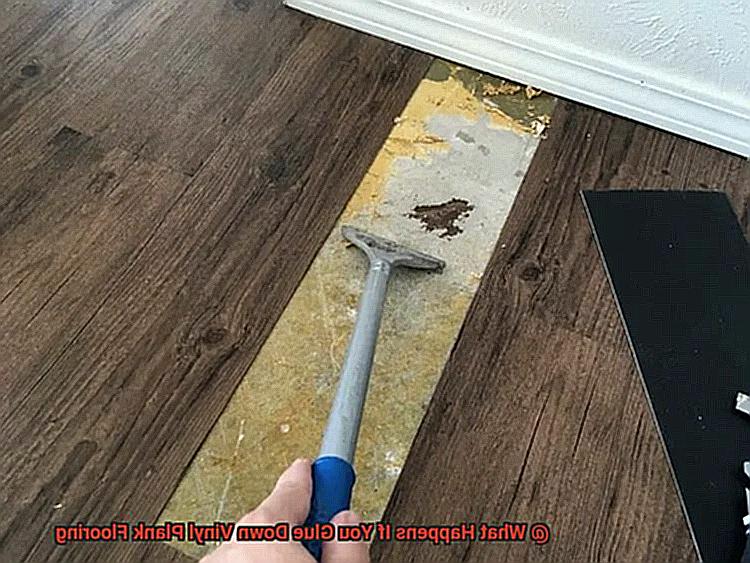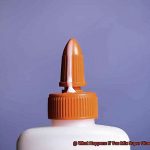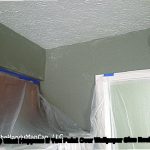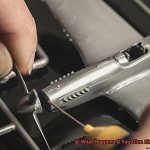Have you ever thought about gluing down your vinyl plank flooring? It might seem like a good idea to prevent any shifting or movement, but before making this decision, it’s essential to understand the consequences. Gluing down vinyl plank flooring can have both advantages and disadvantages, and homeowners should consider them carefully.
One of the significant benefits of gluing down vinyl plank flooring is its stability. When adhered to the subfloor correctly, it can withstand high traffic areas without any issues. However, if not done correctly, it can lead to problems such as buckling or warping.
If you’re considering gluing down your vinyl plank flooring, make sure you know how to do so correctly. Some vinyl planks come with adhesive backing, making installation relatively easy. But if you choose to use additional adhesive, be sure to use the correct type; otherwise, it could cause issues in the future.
In this article, we’ll dive deeper into what happens when you glue down vinyl plank flooring. We’ll explore both the benefits and drawbacks and provide tips for ensuring a safe and successful installation. So keep reading to learn more.
What is Vinyl Plank Flooring?
Contents
- 1 What is Vinyl Plank Flooring?
- 2 Advantages of Glue-Down Installation
- 3 Disadvantages of Glue-Down Installation
- 4 Factors to Consider When Choosing an Installation Method
- 5 Subfloor Preparation for Glue-Down Installation
- 6 Selecting the Right Adhesive
- 7 Tips for Installing Vinyl Plank Flooring with Adhesive
- 8 Alternatives to Glue-Down Installation
- 9 Conclusion
This flooring option is composed of several layers, including a bottom backing layer, vinyl core layer, printed design layer, and wear layer. The printed design layer gives the vinyl plank flooring its realistic wood or stone appearance.
One of the benefits of vinyl plank flooring is its versatility in installation. It can be installed in two ways: floating or glue-down installations. Floating installation involves interlocking the planks without any adhesive, while glue-down installation requires an adhesive to bond the planks to the subfloor.
Glue-down installations are preferred in high traffic areas or areas with moisture, such as bathrooms or kitchens. The adhesive creates a strong bond between the vinyl planks and the subfloor, preventing any movement or shifting over time. It also results in a more stable and secure installation.
However, it is important to note that not all vinyl planks are suitable for glue-down installation. It is crucial to carefully read the manufacturer’s instructions before attempting to glue down your vinyl planks.
While gluing down your vinyl planks can result in a secure and stable installation, it may make it more challenging to replace individual planks if they become damaged or worn over time. Additionally, some adhesives can emit harmful chemicals, so it’s important to choose a low-VOC adhesive and ensure proper ventilation during installation.
Advantages of Glue-Down Installation
When it comes to vinyl plank flooring, there are two popular installation methods – floating and glue-down. While both have their advantages, glue-down installation offers a range of benefits that make it an attractive option for many homeowners.
One of the significant advantages of glue-down installation is its ability to provide a stable and secure floor. When adhesive is applied directly to the subfloor before placing vinyl planks on top, it creates a strong bond that prevents any movement or shifting of the planks. This makes it an ideal choice for high-traffic areas or rooms that are prone to moisture or humidity, such as kitchens and bathrooms.
In addition to stability, glue-down installation can also help reduce noise transmission. Since there is no gap between the subfloor and the vinyl planks, sound is less likely to travel through the floor and into other rooms. This feature can be particularly beneficial in multi-story homes or apartments where noise can be a problem.
Another advantage of glue-down installation is its ability to level out minor imperfections in the subfloor. The adhesive can help create a smooth and even surface for the vinyl planks, saving time and money on subfloor repairs or leveling compounds.
While it’s true that glue-down installation may require additional time and effort during installation compared to floating installation, the benefits of a stable, quieter, and even floor make it worth considering.
Disadvantages of Glue-Down Installation
If you’re considering installing vinyl plank flooring using the glue-down method, it’s important to be aware of the potential disadvantages before making a final decision. While glue-down installation may seem convenient and cost-effective, it comes with its own set of drawbacks that can affect the overall quality and longevity of your flooring.
Firstly, one of the most significant disadvantages of glue-down installation is that it’s time-consuming. This installation method requires precision and patience as the adhesive must be applied evenly and allowed to dry before laying down the planks. This process can take several hours and cannot be walked on until the adhesive is fully cured. So, if you’re looking for a quick and easy installation option, then glue-down installation may not be the best option for you.
Another disadvantage of glue-down installation is that it can be difficult to remove. Once vinyl plank flooring has been glued down, it bonds strongly to the subfloor, making it challenging to remove without damaging the subfloor or leaving behind sticky residue. This can be a significant issue if you need to replace or repair any damaged planks in the future.
Moreover, glue-down installation doesn’t offer much flexibility in terms of making adjustments or replacing damaged planks. If a plank becomes damaged or needs to be replaced, it will require significant effort to remove and replace it without damaging surrounding planks or the subfloor. Therefore, if you anticipate having to make changes or repairs in the future, then glue-down installation may not be the ideal choice for you.
Before gluing down vinyl plank flooring, proper subfloor preparation is essential. Any imperfections in the subfloor can cause bumps or unevenness in the finished flooring, which can be unsightly and pose a tripping hazard. This means that subfloor preparation is a crucial step that cannot be skipped when using this installation method.
Lastly, some adhesives used for glue-down installation may contain harmful chemicals like formaldehyde, which can pose health risks if not handled properly. It’s crucial to choose an adhesive that is low in volatile organic compounds (VOCs) and follow all safety precautions when working with it.
Factors to Consider When Choosing an Installation Method
Before you start the installation process, it’s important to consider the various factors that will impact your choice of installation method. In this article, we’ll explore the top factors to consider when selecting an installation method for your vinyl plank flooring.
First and foremost, the type of subfloor you have is critical. Do you have a concrete or wood subfloor? If you have a concrete subfloor, a glue-down installation may be your best bet as it provides a sturdy and stable foundation for your vinyl planks. On the other hand, if your subfloor is made of wood, a floating installation may be the better option as it allows for more flexibility and movement.
Another factor to consider is the level of foot traffic in the area where you plan to install the vinyl plank flooring. If the area experiences heavy foot traffic, a glue-down installation may be more suitable as it provides greater stability and reduces the risk of planks shifting or buckling over time. However, if the area has minimal foot traffic, a floating installation may suffice.
The type of vinyl plank flooring you choose is also critical in determining which installation method to use. Some vinyl planks come with adhesive already applied to the back, making them suitable for a glue-down installation. Other types may require an additional adhesive layer to be applied before installation.
Additionally, your personal preferences and budget should be taken into account when selecting an installation method. A glue-down installation may be more costly and time-consuming than a floating installation, but it may also provide greater durability and longevity. On the other hand, a floating installation may be quicker and easier to install but may not last as long or provide as much stability.
Subfloor Preparation for Glue-Down Installation
Before you dive in, it’s essential to prep your subfloor properly for glue-down installation. As a subfloor preparation expert, I’m excited to share with you the necessary steps to ensure that your new flooring stays in place for years to come.
The first step is to clean and level your subfloor. Loose debris and material must be removed using a vacuum or broom, and any bumps or high spots should be sanded down for a smooth surface. This step is essential for the adhesive to bond effectively, providing a stable foundation for your new flooring.
Moisture levels in the subfloor can also impact the success of your installation. Be sure to check for moisture using a moisture meter. If moisture levels are too high, consider installing a moisture barrier before proceeding with the glue-down installation. This will help prevent buckling or warping of the vinyl planks down the line.
When it comes to adhesive selection, choose one that is specifically designed for use with vinyl plank flooring. Using a trowel, spread the adhesive evenly onto the subfloor. Be careful not to leave any voids or puddles that could compromise the stability of the flooring.
Finally, be patient and allow the adhesive to dry completely before installing the vinyl planks. Rushing this step could lead to problems with adhesion and overall stability of your floor. The recommended drying time depends on the type of adhesive used and conditions in the room.
Selecting the Right Adhesive
When it comes to installing vinyl plank flooring, selecting the right adhesive can make or break your project. You want your flooring to stay put and look great for years to come, so choosing an adhesive that is compatible with both the vinyl planks and subfloor is crucial.
There are two main types of adhesives used for vinyl plank flooring: pressure-sensitive and hard-set. Pressure-sensitive adhesives are typically used for luxury vinyl tile (LVT) and are applied directly to the subfloor. Hard-set adhesives, on the other hand, are typically used for solid vinyl plank flooring and require a trowel to apply.
But selecting the right type of adhesive is just one piece of the puzzle. You also need to consider moisture levels, type of subfloor, and temperature when choosing an adhesive. For example, if your subfloor is concrete, you’ll want to use a moisture-resistant adhesive to prevent water damage. And if you live in an area with high temperature fluctuations, you’ll want to choose an adhesive that can withstand these changes.
Once you’ve selected the right adhesive, it’s important to follow the manufacturer’s instructions carefully when applying it. Applying too much or too little can result in an uneven bond or cause the planks to shift during installation. To ensure an even application, use a notched trowel to spread the adhesive evenly across your subfloor.
But why is all this fuss necessary? Well, using the wrong type of adhesive or applying it incorrectly can result in a weak bond between the planks and subfloor. This can cause your flooring to shift, buckle, or even come apart over time – not exactly what you had in mind.
Tips for Installing Vinyl Plank Flooring with Adhesive
Installing vinyl plank flooring with adhesive is a great way to get a long-lasting and durable floor covering. But if you want your installation to be successful and last for years to come, there are a few important steps you need to follow. Here are five tips for installing vinyl plank flooring with adhesive:
Choose the Right Adhesive
The first step in installing vinyl plank flooring with adhesive is to choose the right product for your subfloor and environment. There are different types of adhesives available, each with its own set of application methods, drying times, and requirements for subfloor preparation. Be sure to do your research and choose the adhesive that’s right for your specific needs.
Prepare the Subfloor
Proper subfloor preparation is essential for a successful installation. Make sure that the subfloor is clean, level, and dry before applying the adhesive. If there are any bumps or uneven areas, use an appropriate leveling compound or filler to create a smooth surface.
Apply the Adhesive Correctly
When applying the adhesive, it’s important to follow the manufacturer’s instructions carefully. Work in small sections at a time, using a notched trowel to spread the adhesive evenly and prevent any lumps or bumps. Be sure to apply enough adhesive to fully cover the subfloor, but not so much that it oozes up between the seams of the vinyl planks.
Use Spacers
To ensure that the planks are installed evenly and have enough space for expansion, use spacers between each plank during installation. This will help prevent any buckling or warping of the planks over time.
Roll Over the Planks
After installing each section of planks, use a floor roller or weighted object to firmly press them into the adhesive. This will help ensure a strong bond between the planks and the subfloor, and prevent any lifting or shifting over time.

Alternatives to Glue-Down Installation
If you’re considering vinyl plank flooring, the traditional glue-down method may not be your only option. As an expert in the field, I’ve researched some fantastic alternatives that offer a variety of benefits.
First up is the floating floor installation method. This involves interlocking planks without adhesive, making it a mess-free option that’s also easier to remove and replace if needed. Plus, it can be quicker and more cost-effective than glue-down installation.
Another alternative is using a pressure-sensitive adhesive that creates a strong bond with the subfloor without emitting harmful VOCs. It also allows for easy repositioning of planks during installation.
Lastly, some vinyl plank flooring options come with pre-attached backing, eliminating the need for adhesive altogether. This hassle-free option is perfect for DIY installations.
Each method has its own unique benefits depending on your preferences and needs. If you want to avoid adhesive altogether, floating floors are the way to go. If you want easy repositioning during installation, try pressure-sensitive adhesive. And if you want a hassle-free installation process, pre-attached backing is perfect.
No matter which method you choose, proper subfloor preparation is key for a long-lasting and durable result. Always follow manufacturer instructions for your specific vinyl plank flooring product.
1UoRb3SJg24″ >
Conclusion
In summary, gluing down vinyl plank flooring can be a smart choice for those seeking stability and reduced movement in high-traffic or moisture-prone areas. However, it is essential to select the correct adhesive and prepare the subfloor thoroughly to avoid potential issues like buckling or warping.
While glue-down installation offers benefits like noise reduction and leveling out minor subfloor imperfections, it is time-consuming and challenging to remove. When deciding on an installation method, homeowners should consider factors such as subfloor type, foot traffic levels, and personal preferences.
Proper subfloor preparation is crucial for successful glue-down installation, including cleaning and leveling the surface while checking for moisture levels. Choosing the right adhesive is equally vital for a strong bond between the planks and subfloor.
Alternatives to glue-down installation include floating floor installation, pressure-sensitive adhesive, and pre-attached backing options. Ultimately, homeowners must weigh the pros and cons of gluing down vinyl plank flooring before making a decision.






